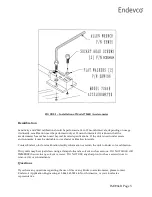
IM7264B, Page 2
®
3. Zero Measurand Output- After the impedance and insulation resistance tests, measure the output of
the accelerometer with zero g acceleration. Turn the unit on its side so that the accelerometer mounting
surface is perpendicular to the table top. Apply the specified excitation voltage to the accelerometer and
measure its output with a DC millivolt meter. Allow the unit to warm-up for two minutes. The
accelerometer should have a Zero Measurand Output (ZMO) within the data sheet specified limits.
If any of these initial checks do not give proper readings, indicating a possible malfunction, and the
reason for the erroneous reading cannot be found, contact Endevco.
Mounting
When mounting or removing the accelerometer, it is essential to utilize proper techniques and tools.
Correct torque is important to ensure correct mounting and performance.
1. The mounting surface should be clean and free of burrs. A recommended surface roughness is 32
micro inch rms.
2. Do not cement the unit to the mounting structure. Use the supplied mounting washers and screws, as
shown in Figure 1.
3. To facilitate easier screw installation, the mounting screws should be lightly lubricated with oil. Slide
the flat washer over the screw.
4. Remove the unit from the protective sleeve. Without the protective sleeve, it is recommended that the
unit be handled by the case, and not the cable. This is to prevent the unit from slapping the mounting
surface during installation. Place the unit on the mounting surface and align the mounting holes.
5. Using the supplied Allen wrench, turn the screws into the mounting holes using the recommended
torque of 3 lbf-in (0.3 Nm). This is roughly equivalent to finger tight with the supplied wrench.
Installation of the unit with higher torque values, dry threads, or thread adhesives is not recommended
as excessive torque will be required to break the screw loose when the accelerometer is dismounted.
6. As practical, tie down the cable within 2 to 3 inches (4 to 6 cm) of the unit. Whipping of the cable
during vibration and shock will strain the cable unnecessarily at the unit.
7. Connect the unit to the signal conditioner and check for proper functioning through the use of
standard techniques such as shunt calibration across the passive arms of the accelerometer.





















